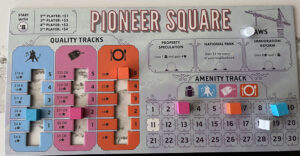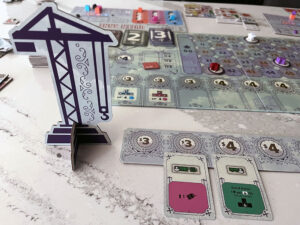 I am from the Chicago area, lived many of my adult years in Chicago, have worked in Chicago for over 20 years, so when I think of great fires, there is only one Great Fire. But apparently, Mrs. O’Leary’s cow was busy in Seattle too, because in 1889, 18 years after the Great Fire of Chicago, Seattle had one too. In Rebuilding Seattle, you and your opponents are city planners tasked with rebuilding Seattle. You each get a District in which to rebuild a neighborhood and whoever builds the best neighborhood, earning the most victory points (VP), wins the game.
I am from the Chicago area, lived many of my adult years in Chicago, have worked in Chicago for over 20 years, so when I think of great fires, there is only one Great Fire. But apparently, Mrs. O’Leary’s cow was busy in Seattle too, because in 1889, 18 years after the Great Fire of Chicago, Seattle had one too. In Rebuilding Seattle, you and your opponents are city planners tasked with rebuilding Seattle. You each get a District in which to rebuild a neighborhood and whoever builds the best neighborhood, earning the most victory points (VP), wins the game.
Gameplay Overview:
Rebuilding Seattle is a hybrid economic engine building, card drafting, and tile placement board game. The game is played over three rounds with each round consisting of four phases.
1. Increase Population
2. Build (on your turn you must do one of the following)
a. Build a building or buy a Suburb
b. Activate one event
C. Enact 1 law (only 1x per round)
3. Profit (Earn $5 per $ on your economic buildings, plus any bonuses from cards
purchased)
4. Clean up
You spend most of the game in phase 2 because during each round you continue in this phase until all 6 events have been activated.

Now I need to rewind to the setup, to help you understand what is meant by each of those phases.
Each player selects a district with a unique and hopefully balanced set of 3 laws (For my Seattle friends, family, and fans the districts are Waterfront, Queen Anne, Georgetown, Industrial District, Pioneer Square, and Capitol Hill). Then each player selects a unique neighborhood card that has a specialty to start, either a larger dining, shopping, entertainment, economic, education, or transportation district. Each player also starts with two Iconic Seattle Landmarks that you can build and have unique end-game scoring bonuses.
Throughout phase two, you will purchase dual purpose cards that allow you to build Tetris shaped buildings that you need to place on your original neighborhood card and/or your suburban expansion tiles. The second purpose of the card is to either increase the quality track of your Restaurant, Shopping, or Entertainment districts (RSE), gain profits based on RSE buildings placed, or in round three gain VP based on transportation, economic, or education buildings.

The three unique laws on each district generate money, VP, increase/decrease population, increase quality track for RSE, and build suburban tiles.
There are six events, three of them score your RSE districts. These are the most important events for scoring VP and gaining money, but initially, they are also the most confusing. As you increase the quality track of each district you have the potential to earn more VP or money, the equation to determine your reward of this event is:
Quality track reward – (your city’s population – your total number of corresponding symbols from your buildings) = Reward… Math is so fun!
The remaining three events are simple to explain. The Expansion Event allows the person that activates the event to purchase a suburb tile for $1 instead of the usual $4 and all players to collect a suburban tile per train symbol in their neighborhood. The Nature’s Impact Event each round scores based on undeveloped terrain to gain $, VP, or reduce population. The Graduation Event reduces the population based on education symbols.

Game Experience:
Once you understand how to score the RSE events you can develop your strategies and the game plays quickly and is fun. But I can’t underscore how important it is to really take the time to understand this scoring system prior to playing. Conceptually, you are trying to develop the neighborhood with the highest quality districts with the lowest population. It is smart to focus on one or two of the districts and then work on decreasing your population by adding education buildings to your neighborhood and by having lakes in round 2.

I love city building, I grew up playing Sim City, and I even was the one big fan of the Sim City Card game. On my first play, I was not a big fan of this game, and couldn’t put my finger on why. It felt like it took elements of game genres that I love and instead of having an additive effect on my enjoyment, it left me with a feeling that was less than if I had just played a game from any one of the genres. However, I am happy to note that my enjoyment of this game has grown with each successive play. The asymmetrical district cards, the variety of landmarks, and even the starting neighborhood tile have provided varied play each time and different strategies have won each game.
Once each player has flushed out their strategy the game speed increases significantly, which is nice because unlike many games the end of the game doesn’t slog on, despite having more income and potentially more time spent in the second phase. An interesting strategy emerges about forcing the game to end by activating the events vs continuing to play and earn more VP. Watching your opponents’ moves can alter this decision as some landmarks have end-game points that benefit from a prolonged game while others could have reached their point maximum earlier in the game.
Final Thoughts:
Rebuilding Seattle is a game that you could dismiss on its first play. The initial setup takes too long, the first play is confusing because of the scoring of the RSE events, and nothing about it jumps out as amazingly fun. It misses a bit on the theme by not having names on the buildings, they are just Tetris pieces with symbols on them.
However, once I bagged each building type, the set-up time decreased and become less of a negative. Now that everyone that plays with me understands the scoring, and we have all tried a variety of strategies, this game has grown on me. The variety of starting bonuses and end-game scoring with the varied landmarks ensure that this game has replay value.
Final Score: 3.5 Stars – Eventually I could see raising this score to a 4. But the first play still sticks with me and again the lack of building design baffles me. That being said, it is fun and I will keep playing.
 Hits:
Hits:
• Combines elements of engine building, card drafting, and tile placement into one fun game.
• The replay value of this game is high.
• Cards and components are of high quality.
Misses:
• The first play is a slog, with the long set up and confusing scoring system.
• While it is fun to combine the elements of those genres, I am not 100% the sum is greater than the parts.
• Lacks the city building that I love as the pieces are not real buildings, they just have symbols of the district that they represent.





















